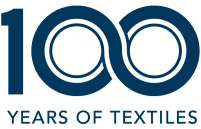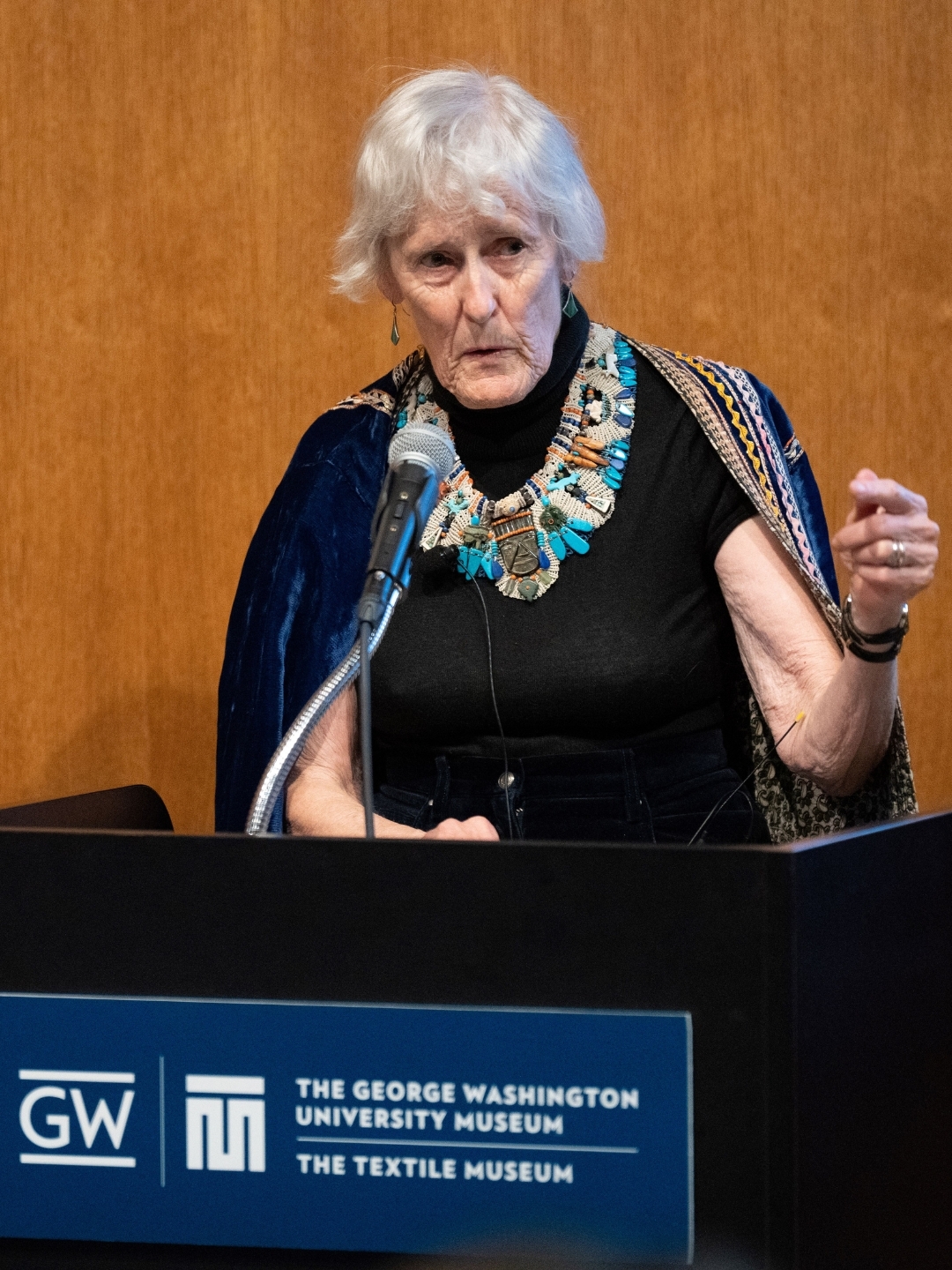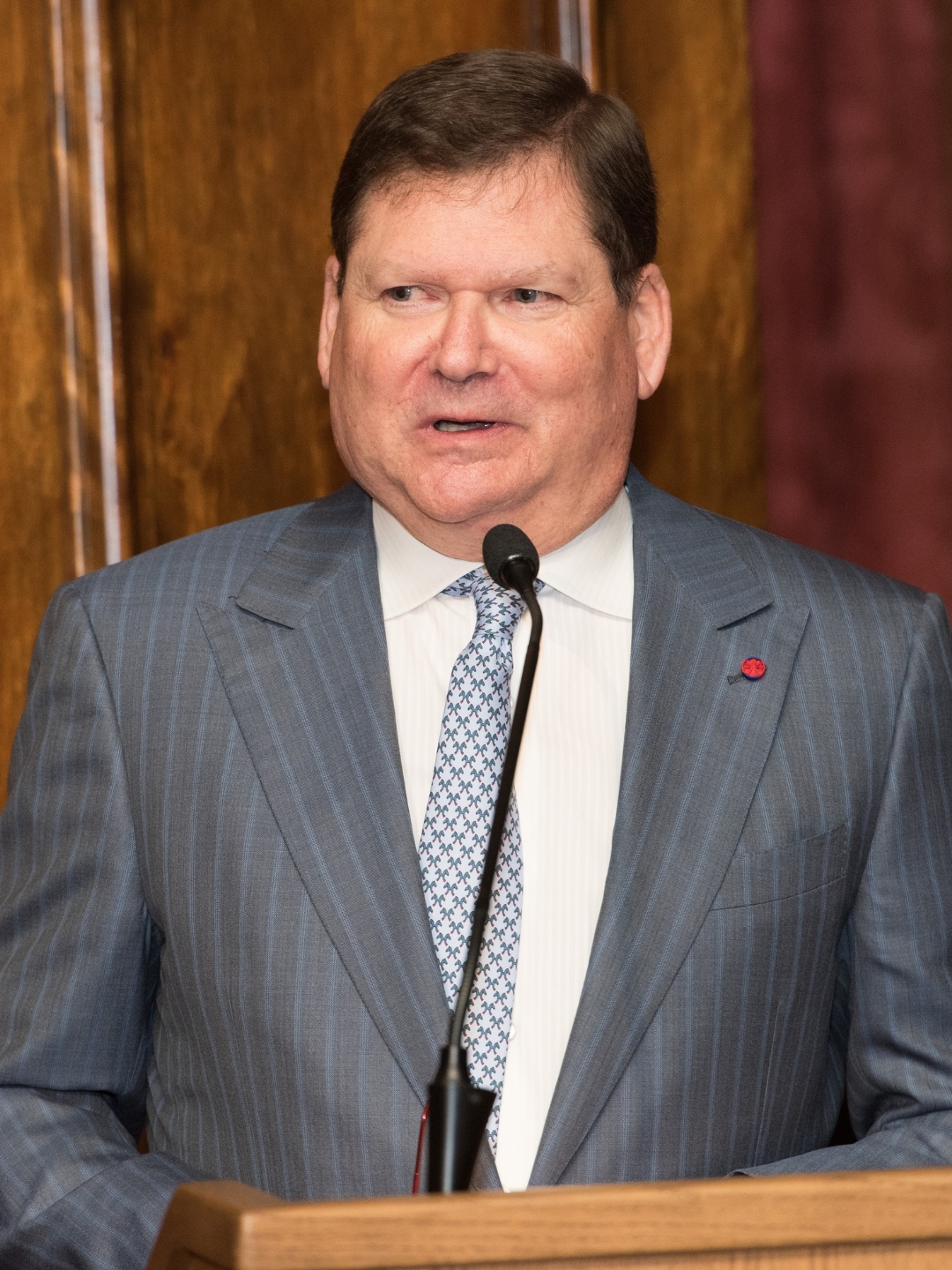Myers Award
The George Hewitt Myers Award honors lifetime achievements and exceptional contributions in the field of textile arts. The award, named for The Textile Museum’s founder and given by the board of trustees, is recognized as the highest international accolade in the field of textile arts.
Past Myers Award Honorees

Photo by Takashi Iwasaki
2024 - Nobuko Kajitani
Conservator
Nobuko Kajitani is a leading authority in textile conservation. She has inspired generations of textile conservators with her object-centered approach, which emphasizes close examination of materials and techniques and the importance of an integrated historical and scientific approach to understand and preserve the cultural legacies of textiles. In addition to documenting her important conservation projects, her publications include papers on pre-Columbian and Middle Eastern archaeological fabrics.
Following her early training at The Textile Museum, in 1966 Kajitani began a 37-year-career at the Metropolitan Museum of Art. She served as conservator in charge of the Department of Textile Conservation from its founding as an independent department in 1973 until Kajitani’s retirement in 2003. In the 1980s, Kajitani shaped the design of the Met’s Antonio Ratti Textile Center, incorporating a textile conservation laboratory as well as a state-of-the-art centralized storage for textiles with adjacent study rooms for both staff and public access.
2022 – Elizabeth Wayland Barber
Archaeologist and linguist
An accomplished scholar and author, Elizabeth Wayland Barber is recognized as one of the world’s leading authorities on ancient textiles. She is professor emerita at Occidental College, where she taught for 37 years before her retirement. Dr. Barber teaches and choreographs for Occidental’s Folk and Historical Dance Troupe, which she founded in 1971. She has also served as a research associate for the Cotsen Institute of Archaeology at UCLA.
Dr. Barber’s years of research into the history and pre-history of cloth and weaving has revealed vital information about the movement of people across Eurasia and Europe, the origin of fabric and weaving, and women’s participation in in the inventions of weaving, cloth and textile arts. Her influential publications include Women's Work: The First 20,000 Years – Women, Cloth, and Society in Early Times (1996) and The Mummies of Ürümchi (2000).
Watch a video recording of Elizabeth Barber's award presentation.
2019 – Thomas P. Campbell
Museum leader and scholar
Thomas P. Campbell became the director and CEO of the Fine Arts Museums of San Francisco in 2018. Dr. Campbell has dedicated his career to the preservation, study and promotion of art as a gateway to human understanding, including drawing attention to the importance of textiles.
A distinguished art historian and expert in European tapestry, Dr. Campbell joined the Metropolitan Museum of Art in 1995. He served as assistant curator in the Department of European Sculpture and Decorative Arts and supervising curator of the Antonio Ratti Textile Center, organizing the acclaimed exhibitions Tapestry in the Renaissance: Art and Magnificence (2002) and Tapestry in the Baroque: Threads of Splendor (New York, 2007; Madrid, 2008). As director and CEO of The Met from 2009 to 2017, Dr. Campbell led a revitalization and modernization achieved through award-winning exhibitions and publications, major capital projects, and historic donations of works of art.
2018 – Guido Goldman
Collector and philanthropist
Guido Goldman was a passionate collector of Central Asian ikat textiles who assembled one of the world’s finest collections of ikats from the region. His collecting and advocacy led to increased preservation, education and public interest in ikat that was instrumental in the modern revival of ikat in Uzbekistan. In the late 1990s, Dr. Goldman organized a major traveling exhibition of his collection, Ikat: Splendid Silks of Central Asia, which was accompanied by a groundbreaking publication.
In 2015, Dr. Goldman donated the finest ikat textile panels from his collection to The Textile Museum in honor of Bruce P. Baganz, making the museum the holder of one of the largest and most notable collections of Central Asian ikats in the world. He was also a 2016 recipient of the Joseph V. McMullan Award for Stewardship and Scholarship in Islamic Rugs and Textiles.
2016 – Yoshiko Iwamoto Wada
Artist and scholar
Yoshiko Iwamoto Wada is an artist, curator, historian and educator who has advanced the fields of historical textiles and contemporary fiber art. She is president of the World Shibori Network, founder of Slow Fiber Studios and producer of the Natural Dye Workshop film series. She leads workshops and lectures on sustainability, tradition and design innovation in natural dyes, resist-dyeing and material reuse. She is the author of publications on Japanese art, including Shibori: The Inventive Art of Japanese Shaped Resist Dyeing (1983).
An accomplished artist, Yoshiko’s own work has been exhibited at institutions including the Renwick Gallery of the Smithsonian American Art Museum and the International Textile Fair in Kyoto. She has also curated or co-curated exhibitions at the Museum of Craft and Folk Art in San Francisco, the Jim Thompson Art Center in Bangkok and The Textile Museum.
2015 – Bruce P. Baganz
Museum leader
Since 2004, Bruce P. Baganz has served as chairman of the Board of Trustees of The Textile Museum. In 2012, he became co-chair of the joint board of The George Washington University Museum and The Textile Museum. Through his leadership, The Textile Museum reopened in 2015 in new facilities at GW with a university affiliation that has secured the museum’s international prominence in textile scholarship, education and fostering cultural understanding.
Dr. Baganz is president and CEO of Security Energy Company. He is chairman of the Near Eastern Art Research Center, a member of the Board of Visitors for the University of South Carolina’s College of Arts and Sciences, and a former board member of the National Trust for the Humanities. In 2008, Dr. Baganz was honored with the Joseph V. McMullan Award for Stewardship and Scholarship in Islamic Rugs and Textiles. An internationally known collector of antique textiles and rugs from the Middle East and Central Asia, Dr. Baganz is editor of a forthcoming book on Central Asian "suzani" textiles.
2012 – Walter B. Denny
Educator and author
Walter B. Denny is University Distinguished Professor Emeritus of the History of Art and Architecture at the University of Massachusetts, Amherst, where he taught for 53 years. His primary field of teaching and research is the art and architecture of the Islamic world, especially the artistic traditions of the Ottoman Turks; Islamic carpets and textiles; and economics and patronage in Islamic art.
Dr. Denny was honorary curator of carpets and textiles at the Harvard University Art Museums for three decades, senior scholar in residence in the Department of Islamic Art at the Metropolitan Museum of Art from 2007 to 2017, and is the Charles Grant Ellis Research Associate in Oriental Carpets at The Textile Museum. He has curated more than two dozen exhibitions and authored more than 200 publications on Islamic art, including carpets, textiles and ceramics.
2011 – Milton Sonday
Artist and scholar
Milton Sonday is a scholar and educator on textile techniques, structures and patterns, especially complex weaves and European laces. His educational seminars have trained researchers and scholars on structural analysis for historical textiles. His research archive — including color-coded drawing, paper construction and pencil illustration diagrams of textiles — is preserved at the Antonio Ratti Textile Center at the Metropolitan Museum of Art.
Sonday joined The Textile Museum staff as a draftsman in 1961 and later served as assistant curator of the rug collection. He published extensively with The Textile Museum, including Woven from the Soul, Spun from the Heart (1987). In 1968, he began his 30-year tenure at the Smithsonian’s Cooper-Hewitt National Design Museum, during which he helped to bring about significant additions to their collection. Sonday was a founding member and past president of the Textile Society of America.
2010 – Michael Franses
Author and publisher
Michael Franses is an independent scholar, author and publisher of numerous books and periodicals relating to the textile arts. He is co-founder of Hali, the quarterly magazine dedicated to carpets and textiles that is a leading resource for international collectors and connoisseurs. He is also co-founder of the International Conference on Oriental Carpets, co-organizing its first conference in 1976.
Franses comes from a family of dealers of antique carpets and textiles in the U.K. He owned The Textile Gallery in London from 1971-2007. In the 1980s, Franses founded a textile conservation studio, and in 1993 he established Textile & Art Publications. In 2009, he received the Joseph V. McMullan Award for Stewardship and Scholarship in Islamic Rugs and Textiles. Today, Franses continues to consult, conduct research and publish on carpet and textiles, in particular from Central Asia and China. He serves as board chairman of HALI Publications Limited.
2009 – Mattiebelle Gittinger
Scholar
Mattiebelle Gittinger was a foremost scholar in the field of Southeast Asian and South Asian textiles. Beginning in the 1970s, she conducted extensive fieldwork documenting textile traditions across Southeast Asia, India, Europe and the Middle East. She also promoted the work of contemporary artists dedicated to sustaining traditional textile techniques.
As research associate for Southeast Asian textiles at The Textile Museum for more than four decades, Dr. Gittinger researched, curated and organized numerous exhibitions, including Textiles for This World and Beyond: Treasures from Insular Southeast Asia (2005), Textiles and the Tai Experience in Southeast Asia (1992-93); and Master Dyers to the World: Technique and Trade in Early Indian Dyed Cotton Textiles (1982-83). She also helped the museum to build one of the world’s finest collections of Southeast Asian textiles. Dr. Gittinger was a founder of the Textile Society of America.
2008 – Jon Thompson
Scholar
Jon Thompson was a world-renowned carpet specialist who significantly advanced the field of carpet studies. From 2001 to 2007, he was the May Beattie Fellow in Carpet Studies at the University of Oxford’s Ashmolean Museum of Art and Archaeology and the Khalili Research Centre, where he directed the work of the Beattie Carpet Archive. He taught courses on carpets and textiles of the Islamic world at institutions including Oxford University, the School of Oriental and African Studies, the V&A Museum and the British Museum.
Dr. Thompson’s publications include Timbuktu to Tibet, Exotic Rugs & Textiles from New York Collectors (2008), Milestones in the History of Carpets (2006), Silk 13th to 18th Centuries: Treasures from the Museum of Islamic Art Qatar (2004), Textiles through the Ages (2003) and Silk, Carpets and the Silk Road (1988). He first became interested in carpets and textiles while practicing medicine in London.
2007 – Lloyd Cotsen
Collector and philanthropist
Lloyd Cotsen was a business leader, philanthropist and prolific collector. Driven by his passion for art and archaeology, he assembled the Textile Traces Study Collection, containing nearly 4,000 small-scale textiles and fragments from around the globe. He supported scholars and contemporary artists in conducting first-hand research using his study collection, adding to public knowledge and understanding of human creativity from antiquity to the present day.
Cotsen built his career as president, CEO and chairman of Neutrogena Corporation. He served as a board member of The Textile Museum from 1985-2004. His textile collection is now in the care of the Cotsen Textile Traces Study Center, which opened at The George Washington University Museum and The Textile Museum in 2020. His other art collections were gifted to institutions including the Museum of International Folk Art in Santa Fe, the Asian Art Museum in San Francisco, UCLA and Princeton University.
2006 – Josephine Powell
Ethnographer and photographer
Josephine Powell was a photographer and collector of Anatolian ethnographic textiles. Her extensive travel as a freelance photographer brought her across the Middle East, the Indian subcontinent and North Africa. Her photographs have been published extensively and are regarded as the gold standard of documentary photography of architecture.
Powell visited Türkiye for the first time in 1955, where she became interested in Turkish flatwoven textiles. Seeking to improve on knowledge of the provenance and designs of these textiles, she worked with Turkish nomads, gathering information about their handicraft. Over the next 20 years, Powell photographed the nomadic way of life, which had been largely ignored by scholars. During this time, she began collecting Anatolian kilims, sacks, bands and related artifacts. Her collections, which reflects the role and importance of weaving in rural Anatolia, are now housed at the Koç University in Istanbul.
2005 – Jack Lenor Larsen
Designer
Jack Lenor Larsen was an internationally renowned textile designer, author and collector. He was known as one of the world’s foremost advocates of traditional and contemporary crafts. His skills as a successful designer were enhanced by his studies of architecture, furniture design, ancient Peruvian textiles and weaving. In 1952, Larsen founded the Larsen Company, which became a leading resource for signature fabrics in the international design trade and set a new standard in textile design.
In addition to his contributions as a textile designer, Larsen published books on weaving, textile dyeing, art fabrics and interior design. Larsen received numerous honors during his career, and his artwork is in the permanent collections of major institutions including the Art Institute of Chicago, the Louvre, the Museum of Modern Art and the V&A Museum. His home, LongHouse Reserve in Long Island, continues to welcome visitors seeking sanctuary and creative inspiration.
The Textile Museum Award of Distinction
The Textile Museum Award of Distinction recognizes exceptional contributions that have significantly advanced the museum in the fulfillment of its mission.

















